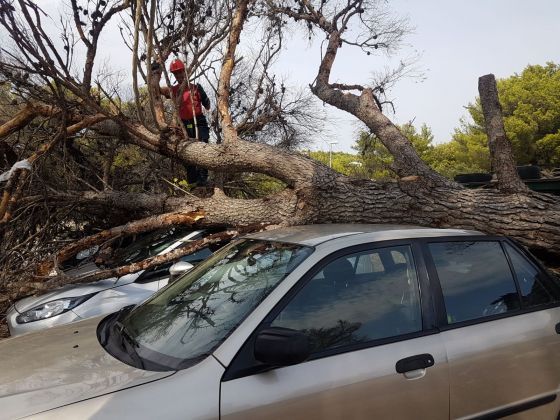Experts say climate change is only partially to blame for recent catastrophic floods that hit Croatia
The list of meteorological stations where record precipitation quantitites were measured this month is getting longer and longer, reports Deutsche Welle on September 22, 2017. According to Croatian Meteorological and Hydrological Service (DHMZ), this September already brought the most rain in history of weather stations in Velika Gorica, Krapina, Poreč, Ogulin, Zadar, Zemunik, Zavižan and Zagreb. Rab island saw the largest precipitation quantity that was ever recorded in any of DHMZ stations – 540 litres per square metre. On September 11, 188 litres of rain per square metre were recorded in Zadar; a day later, it was 300 litres. However, the overall damage was larger than 30 years ago, when Zadar was hit by an even more serious flood.
Meteorologist Dunja Mazzocco Drvar said that the forecast for this summer turned out to be accurate; a drought hit Dalmatia as predicted, and it's a pity no one thought to better prepare for expected wildfires. At the end of August, first forecasts for autumn were stating September was going to be dry and warm. "And then, something happened", said Mazzocco Drvar, adding there's no simple explanation for the current weather conditions. She thinks the culprits might be the tornadoes that ravaged the Carribean and the south of the US: the intensified activity on the Atlantic led to weather in Europe getting out of balance.
"Experts have warned that climate change would lead to more frequent catastrophic meteorological events, from flash floods to droughts, and we should really start to think about irrigation", said Mazzocco Drvar, adding we're about to see a lot less of what we consider to be 'normal' weather. Climate change is affecting the seasons, causing typical winter days to happen in summer, and summer days to pop up in winter.

Ivan Toman / Dalmacija danas
Josip Rubinić, assistant professor at the Faculty of Civil Engineering in Rijeka and a member of a project group at the Ministry of Environment that's working on the Strategy for climate change adaptation, said we can count on more hydrological extremes in near future. He stated we can expect precipitation quantities in Croatia to increase up to 20% before 2040, according to certain models and climate change predictions. However, he thinks climate change isn't to blame for catastrophic floods, but that they are partially caused by inadequate drainage systems and the current state of the sewage system in the whole country.
Rubinić cited the example of Pula, a city that doesn't get much rain, yet has issues with frequent floods. "It's a city whose basic infrastructure was built in the age of Austria-Hungary, and it just can't cope with the current population. A previous upgrade to the sewer system didn't manage to decrease the risk of larger quantities of water, so the City initiated implementation of certain up-to-date systems of water drainage", said Rubinić.
In the last 100 years, the sea level rose for 20 centimetres. Some of the old bridges – those in Nin, for example – suddenly weren't located high enough above the surface anymore, and weren't able to let water pass underneath. As stated in the proposal for climate change adaptation, the sea level is about to rise for another 40-65 centimetres before 2100 – what's going to happen then?
Rubinić considers Croatia should reconstruct its water drainage systems, but also the concept they were built on. Introducing larger sewers in inhabited places would have a limited effect, as settlements expand over time, as well as their residents' needs. Coastal towns are slowly losing their green areas that are able to absorb water; they are now paved, and water is washed away through a storm drain into sewers that can't take such large quantities at once.

Crometeo
"The rest of the world is trying to manage rainwater and slow it down as much as possible, building retention basins to hold the water in a certain area. They are living with floods instead of fighting them, even though the latter can be necessary in urban areas. But it's better for the rain to flood parks, for example, as the ground will absorb it, while we are trying to pass the water on as quickly as possible, only creating problems for other places downstream", said Rubinić. He cited an example from the US, where one has to pay a larger fee for water drainage if they want the rain redirected from their roofs to a public surface, than if they kept it in their own garden or any sort of retention basin. "In these parts, we cover everything in concrete, close it down, direct the water to public surfaces and then we're suddenly faced with a problem", said Rubinić.
Mazzocco Drvar added there was another issue in such cases: inadequate collaboration between meteorologists and competent authorities. Even though they announce upcoming storms, heavy rain and strong wind, it seems we still don't have a system that would react in time. Utility companies get a warning at least 24 hours in advance, and yet, they don't go out into the field to cut down the dry branches around town or check whether drains are clogged. Medical institutions don't assign special teams which could quickly react in case of emergency.

DVD Primošten
According to Mazzocco Drvar, the prevention system should be running so smoothly, citizens shouldn't be able to feel something was going on. Instead, meteorologists have to issue red alerts – and it still isn't enough, as rescue services only intervene once it's too late.
Translated from Deutsche Welle.


